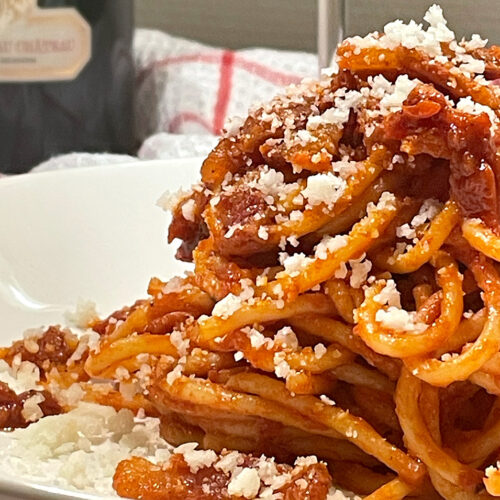
Authentic Pasta Amatriciana
Pasta Amatriciana is as classic an Italian pasta as you’ll find. And for good reason. It’s lightning fast to prepare. It requires few ingredients. And thanks to savory guanciale and pecorino cheese, it’s packed with flavor. Pasta Amatriciana is an easy, comforting pasta with a rich, meaty sauce. What’s not to love?
Ingredients
- 100 g (or 3.5oz) Guanciale
- 200 g (or 7oz) Pasta
- 50-100 g (or 1.75-3.5oz) Pecorino Romano
- 1 can or jar Whole Peeled Tomatoes or Tomato Passata 400 grams / 14.5 ounces
- Extra Virgin Olive Oil optional
Instructions
- Cut the guanciale. Cut the guanciale into small pieces, about ¼ inch thick and ½ to 1 inch long (1.25 - 2.5cm).
- Cook the guanciale. Starting in a cold plan, cook the guanciale on medium heat until it’s brown and crispy - about 5-7 minutes. The guanciale should render a layer of oil that coats the bottom of the pan. About half way through, add some crushed black pepper to the pot. Adding pepper to the hot oil at this stage is going to allow you to extract maximum flavor from the pepper, while imparting it into the guanciale, as well. Once the guanciale is brown, remove it from the pan with a slotted spoon and set it aside. Do not discard the oil.
- Simmer the sauce. Add the tomatoes or the passata to the pan with the oil from the guanciale. If you’re using canned whole tomatoes, break them up with a fork to release their juice. Cook for between 15-20 minutes, keeping the heat on medium and stirring occasionally. The sauce should reduce quite a bit, while at the same time absorbing the fat from the guanciale.
- Cook the pasta (2 minutes shy of al dente). Once the passata is in the pan, bring a large pot of water to a boil. Add a tablespoon of salt. When the water is boiling, add the pasta to the water. Cook the pasta for about two minutes shy of the required al dente cooking time, stirring occasionally.
- Reserve a mug of pasta water. 1 to 2 minutes before removing the pasta, reserve a large mug of the pasta water. Add the reserved pasta water to the cooked passata and combine thoroughly. The agitation is going to emulsify the starch from the pasta water and the sauce. The sauce should start to take on a glossy appearance.
- Add the cooked pasta to the sauce. Once the pasta is cooked, add it to the sauce. Using tongs, gently toss the pasta. This is going to help coat the pasta, while further emulsifying the sauce. After about 2 minutes of tossing the pasta, plate it.
- Serve. Serve immediately with the grated pecorino romano and freshly ground black pepper.
Notes
* The amount of liquid in your sauce will vary depending on whether you used canned tomatoes, a jar of passata, and their respective size and amount. If you feel the sauce has reduced too much, add a bit more pasta water. If there’s enough liquid for your liking, feel free to add less. It all depends on how you like your sauce, as well as the ingredients you have on hand.
* Do not skip adding at least a bit of pasta water to the sauce. The starch in the pasta water is crucial for emulsifying the sauce, adding flavor and texture.
* For added depth of flavor, after cooking the guanciale and reserving it, and before adding the passata or tomatoes, you can deglaze the pan with a splash of white wine. Be careful and add it slowly. Pouring it in too quickly could spray hot guanciale oil.